Author’s Comments
I was asked to shed some light on the statistical realities versus the statistical narrative surrounding domestic abuse, which has long dominated the debate over reform of the family justice system. Here I share the key findings, which have been identified through simple application of published statistics, logic and basic mathematical calculations. Having carried out this analysis, I find it surprising that with no funding or academic resources to call on – to produce these insights – as to why it seems to never have occurred to anyone to get to grips with it before now? Particularly those in the Ministry of Justice, the Police and in Government, all of whom have such deep pockets and so plentiful a supply of highly intelligent resources to call upon, and that is before considering the fact that they have ready access to the data at the very point of collection, so could very easily have been tracking this all along to aid their decision making, in the genuine best interests of children & families. The cynic in me asks, what possible reason could there be to not record the data correctly, then publish it transparently? I have yet to meet anyone involved professionally in any aspect of family law who is lacking in intelligence, so I can only conclude that the absence of transparency, and the desire to make critical and life changing decisions with regards to children and their parents, with what you will see from reading through this document amounts to nothing less than a scandalous and deeply harmful false narrative, is rooted in corrupted financial vested interests. I challenge those professionals involved, to demonstrate rationally, factually and with evidence, that the quite extraordinary lengths they have gone to in preventing transparency and resisting reform over the last three decades, could be motivated by anything other than that.
For those who may wish to use this document in their own work, they have my endorsement provided I am referenced as the author, and it is not for financial gain. An email address is contained in the footer, for any notifications, or even if someone has challenges to the calculations or logic which have been applied.
This analysis is provided in the absence of clear data being made available by The Ministry of Justice, who continue to fail to share any data that would present the public and parliament with a clear picture of both the levels of service being delivered and the outcomes for service users, this is despite repeated criticisms stretching back many years, met with repeated promises to do better, which never materialise. More importantly, is this data could support children, whose best interests they are mandated to serve, yet are evidently failing on a scale that is almost unimaginable, and continues to escalate at a frightening pace and with severe social consequences.
Crime and domestic abuse data
Headline crime and domestic abuse/violence (DA/DV) data, recorded by police and via the national crime survey, carried out annually by the Office for National Statistics (ONS), is frequently relied upon by mainly women’s domestic abuse charities/groups and the media to sensationalise and exaggerate the issue of domestic abuse and present a gendered imbalance in the prevalence. Indeed, the UK Statistics Authority upheld a complaint about the claim by women’s domestic abuse charities and advocating parliamentarians that the “overwhelming majority of Domestic Abuse is perpetrated by males against female victims”, despite upholding the complaint, this very same rhetoric is now more mainstream than it has ever been.
1. According to the ONS National Crime Survey for England & Wales 2019[1], 2.4m adults experienced DA last year. That number equates to 5.7% of the 39.75m adult population aged 16 to 74, but now factor in that the lower figure of 4.2% is recorded as “partner abuse” as opposed to abuse between other family relationships (such as between step siblings for example). We then further consider that 60% of reports of DA are couples with no children in the home (NCS 2019), therefore this survey for family law purposes gives us an assumed prevalence of 40% of 4.2% of the adult population aged 16 to 74 (which totals 39.75m) which comes to approx. 0.67m. The NCS 2019 then shows that approx. two thirds of victims are female, and one third are male, which amounts to approx. 0.42m female v’s 0.25m male.
1.1 Police recorded 1.3m domestic abuse related incidents and crimes in 2019. Of these, 746,219 were recorded as actual crimes in the report rather than an incident; the distinction here is whether the incident being reported meets the threshold of a crime having been committed, i.e. a report of physical violence, sexual assault or stalking, versus an incident where a couple may have had a heated disagreement that resulted in a call being made to the police by a concerned neighbour, or just a neighbour annoyed by the amount of noise they are making.
We know that we need to dilute this for family law purposes by 60% (because that, according to ONS, is the percentage of partnerships with dependent children that fall into scope) so by doing that the number falls to 298,487 recorded as actual crimes, but of course yet to be tested on evidence or even have charges brought.
1.2 There are 8m families with dependent children, but of this 1.7m are lone parent families and 90% of lone parent families are headed by a mother (ONS Census). However, one needs to acknowledge that of those lone parent families, a significant proportion will have intimate relationships but are not living together, and it is just as likely there will be domestic abuse in those relationships as there is in cohabiting couple relationships, and so they will take up an equal proportion of the reports to the police, but would not take up an equal proportion of family court time because they are not jointly responsible for the same children.
a. Therefore, in 8m families, 298,487 domestic abuse crimes are recorded, which equates to 3.7%, not diluting at all for the likelihood that some of these crimes would not be related to the couple, or a parent on a child, but perhaps between step siblings for example. But let’s dilute that again by 21% (the number of single parent households) because in theory at least, DA/DV recorded amongst lone parent households should not end up in family court unless its public family law, as there would be no parent v’s parent custody battle over the children. Therefore, that gives us a relatively reliable prevalence figure of 2.94% and the attributable recorded crime figure should be in the region of 235,804.
b. Next, consider that individual households will report more than one crime, indeed, from our survey of victims of false allegations in family court, a sample of over 200 participants, we found that the average number of police reports made against them was 7.13. If we were to extrapolate that out to all of those claiming false allegations in family court, circa 30,000 plus last year, we are talking about perhaps as many as 213k false reports of crime which are not only being recorded and then not expunged, but also they are not subsequently reversed to be assigned as a crime committed by the person making the allegations against the person they have falsely accused.
c. This implies, that as many as 90% of crime reports the police are burdened with from the relevant population pool are false, and made for the purposes of family court litigation. Further, if as many as 213k DA recorded crimes are both false and attributable to the ‘active in Family Court’ pool of the population, then the way Family Court is operating is the root cause for 28.54% of all police time taken up by reporting domestic abuse crimes. However, until we are able to have reliable data from source to back up any such claims (and I believe collection of that data at source is easily achievable at very low cost), I will exclude this from the calculations altogether to avoid any contention.
d. We are now left to work with a very generous figure of 2.94% DA/DV flagged crime prevalence reported to police, which would qualify as relationships that might end up in a family court if there were a separation, but only IF each person reporting only reported once in the year.
e. Sir Andrew McFarlane, President of MoJ Family Division, commented that the prevalence of DA/DV allegations in family court is 62% of all private law cases[2]. That is a difference of 59.06%, or just under a multiple of 21 x the national prevalence. Doesn’t seem feasible does it?
f. So, we delve deeper, the figure of 746,219 is for reported crimes. This figure drops dramatically for charges being brought on the basis of sufficient evidence to approximately 10% of reports, with a conviction rate of about 70% of those charged, which gives us an approximate conviction rate of just 0.14% (of the population) where there was sufficient evidence to secure a conviction. That conviction rate is for all domestic abuse related crime, so it must be diluted again to take into account DA where there are no children, which takes us to 0.056%. But that’s not all, we must dilute this figure once again to take into account single parent households, and that brings us to a final figure of around 0.044% prevalence. Therefore, evidence sufficient to secure a criminal conviction among households you would assume to have reason to bring up DA/DV allegations in family court is seemingly over exaggerated by as much as a multiple of 1,400 (or in percentage terms 140,000%), based simply on the 62% figure given to us by Andrew McFarlane which I referenced in (e) above. Once again, to reach this level of DA/DV prevalence legitimately is, quite simply, not feasible!
g. Vested interest groups, such as; family law solicitors, women’s domestic abuse charities and a number of high-profile female MP’s; make the claim that family court allegations are true at the same rate as guilty verdicts in the criminal justice system. Yet in the family law system, despite part 17.6 of the family law procedures, any form of consequence for false allegations of any kind of abuse is verging on non-existent. Put simply, there is no deterrent, and accusers quite literally have all to gain and nothing of any consequence to lose! You could even go so far as to call this an ‘Invitation to Commit Perjury’ with a get out of jail free card which is likely made out of gold, and encrusted with diamonds for good measure.
h. The Police Crime Report[3] tells us that the conviction rate is approx. 70% for domestic abuse flagged crime, however it is useful to note that the Crown Prosecution Service reports a conviction rate of 76%[4] for these crimes, whereas Refuge charity, for example, report a ‘success rate’ for cases where they provide advocacy support for “victims” of just 40%, leaving a failure rate of 60% on all cases they manage to persuade the CPS to take to trial through the criminal justice system, 841 cases in total last year, with 498 NOT GUILTY but still referred to as “perpetrators” in their annual report of 2018[5]. If Women’s Aid federated charities are pursuing convictions at a similar rate to Refuge, these figures are merely the tip of the iceberg!
This appears more than just a little suspicious effort of Refuge, Women’s Aid and other domestic abuse charities, but also seems to explain the dilution in overall conviction rate, while calling into question the involvement of these charities and their seemingly vigilante style approach to procurement & coaching of new “victims”. Add to this, the potential undermining of the system to pervert the course of justice and materially impact child safety & wellbeing, not to mention the mental health of targeted innocent parents and their close support network, should they be fortunate enough to have one. Please take note of these recent tweets from Refuge and Women’s Aid.
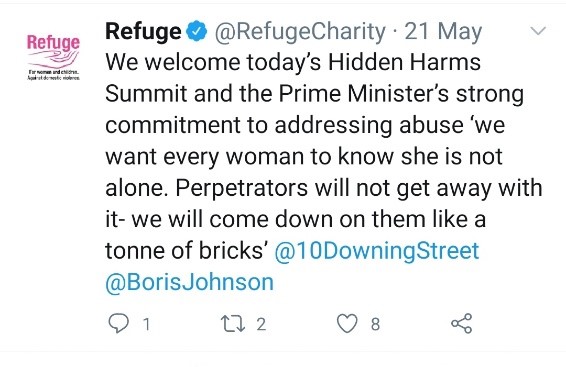
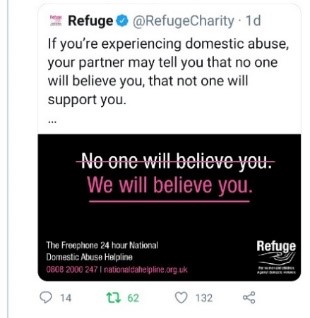
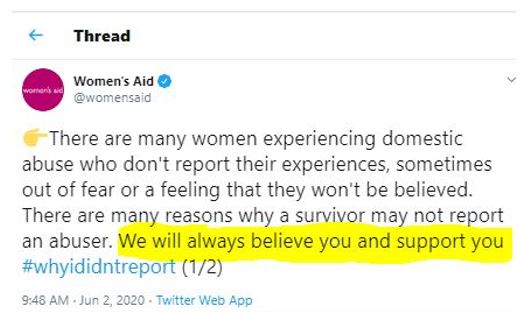
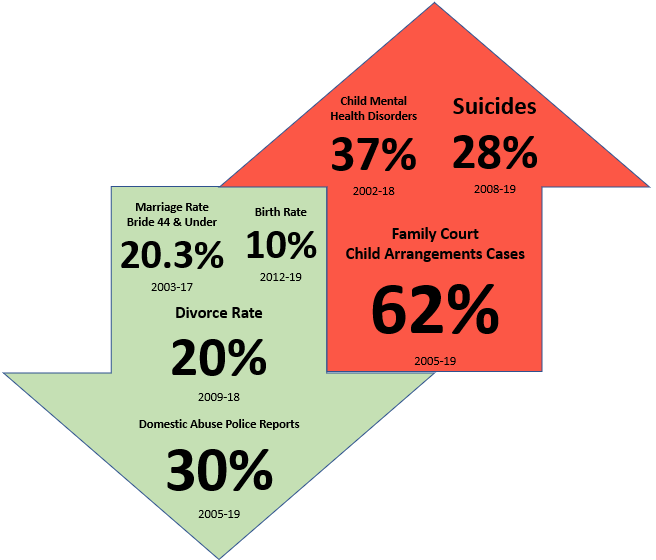
Of course, it makes perfect sense that the rate of domestic abuse crimes would fall over this time period, because of successes coming from the investments made into awareness and support. But the rhetoric of those benefitting the most from the dramatically increased funding over the course of those years (namely Women’s Aid and Refuge), is that we have had an explosion of domestic abuse, perhaps as a result of those investments, even though the crime figures and social markers tell us the polar opposite. It simply cannot be both, so which is true? Well, neither Women’s Aid or Refuge have been required to evidence their claims, so it seems to stand to reason that they have simply made them up and been believed, with the media complying due to the sheer scale of investment these organisations are making into advertising.
3. Let’s make an assumption that DA/DV allegations made in family court would legitimately have a 10 x multiple of the overall national prevalence, which is driving those relationships to failure, that seems quite a generous multiple.
This gives us a 0.44% legitimate prevalence of Domestic Abuse which would mean that of 105k children overseen by Cafcass, the likelihood is that only 462 of them have genuinely been exposed to domestic abuse/violence in a given year. Tragic as that is for those children and their parent that was a victim, it also tells us that as many as 104,538 children (99.56%) have likely been exposed to Parental Alienation (PA). (The link being made between false allegations and PA here is because the only feasible purpose for allegations to be made in these cases is with the intention of severely restricting, or denying altogether, contact between the accused parent and the children. Therefore, PA through unjustified contact denial, at the very least, also giving the opportunity to inflict further aspects of PA on the children without any restriction). If this seems too low, then let’s multiply the prevalence from the conviction rate by 100 rather than by 10 (even though doing so takes quite a stretch of the imagination), this still leaves us with 95.6% of the 105k children exposed (or at least potentially exposed) to PA, so that comes to 100,380 children denied a parent for an indeterminate period of time, and often permanently, while very likely being emotionally/psychologically abused with the blessing of family court and supporting services, in the year of 2018/19 alone.
4. The figure for the volume of children affected should not be compared with the total number of dependent children in the population, but rather it should be mapped against the birth rate, which in 2018 was 657k. This is because every year we are adding more children into the pool (and of course at the other end children are maturing out of the system when they reach 18 at the latest), and the experiences of those children are all too often drawn out over many years and even into their adult lives. Comparing against the birth rate, 15.9% of children came under Cafcass oversight in 2018/19 in private law cases (plus an extra 4.5% in public law – totalling 20.4% of all children through family court), while the numbers indicate that at least 15.3% of all children are being actively alienated through family court processes each year, and doubtless many more outside of the FC process. According to the figures in Cafcass Annual Reports in the 7 years between 2013 & 2019, growth in cases amounts to 42.7%, which gives a year on year growth rate of 6.1%. It is perhaps no surprise then, that the NHS report[9] that 1 in 8 of the nation’s children between 5 & 19 have a mental health disorder, where in 2002 that figure was already raising alarms at 1 in 11, but is now on track to be 1 in 5 by 2035. The No.1 most prevalent adverse childhood experience attributed to this rise, is parental separation and the consequences of that.
As conditions in our family law framework, with the pending introduction of the Domestic Abuse Bill, seem set for even more leniency towards false reporting, coupled with even greater restrictions placed on parents facing allegations of abuse proving their innocence, the forecast looks very bleak indeed for a continuation of this year on year growth, and so within 18 years, we will see at least half of all children passing through this system, with the ever worsening social markers that go along with this, continuing to spiral. At what point will the professionals in the family law industry be content with the level of destruction being caused, or is their desire for destruction simply insatiable?
On the specific topic of false reporting, examining that further lends yet more weight to the argument that the overwhelming majority of allegations of abuse in family court are false, and therefore the reasons for court involvement in child arrangements litigation is completely fabricated in nearly all cases. The results of a Freedom of Information request to Cafcass[10], asking for the ages of children at point of application stretching back 10 years, provided some startling revelations. Earlier I stated that 15.3% of children are now overseen by private family law procedures during their childhood, but the outcome of this FoI request reveals something even more concerning, which is that cases are heavily concentrated on children between the ages of 4 and 8 years old, with children at each of those age years, numbering 7 x those aged 16, with a rapid decline in case numbers being seen where children are aged 11 through to 16. Why? Surely it would make sense, if Domestic Abuse is a driving factor in parental separation and the need for court intervention, then we would see relative uniformity across the ages of the children? Could it be that accused parents are 7 times more abusive/violent/drug or alcohol dependant/incompetent/have mental health issues, than when the children of the family are 16? Could that be just a one-year blip? The answer is no, over the course of 10 years, the pattern is the exact same every year, the only statistically significant variance being that more and more children are added to the pool each year. What, then, is driving this disparity in ages of children involved in custody disputes? I feel that there can only be one feasible answer to this, and that is the self-serving needs of the vast majority of accusing parents, coupled with the predatory nature of family law solicitors, who facilitate, encourage and entice with that all too well known promise, “I can get you more” swiftly followed with “these are the claims you need to make”.
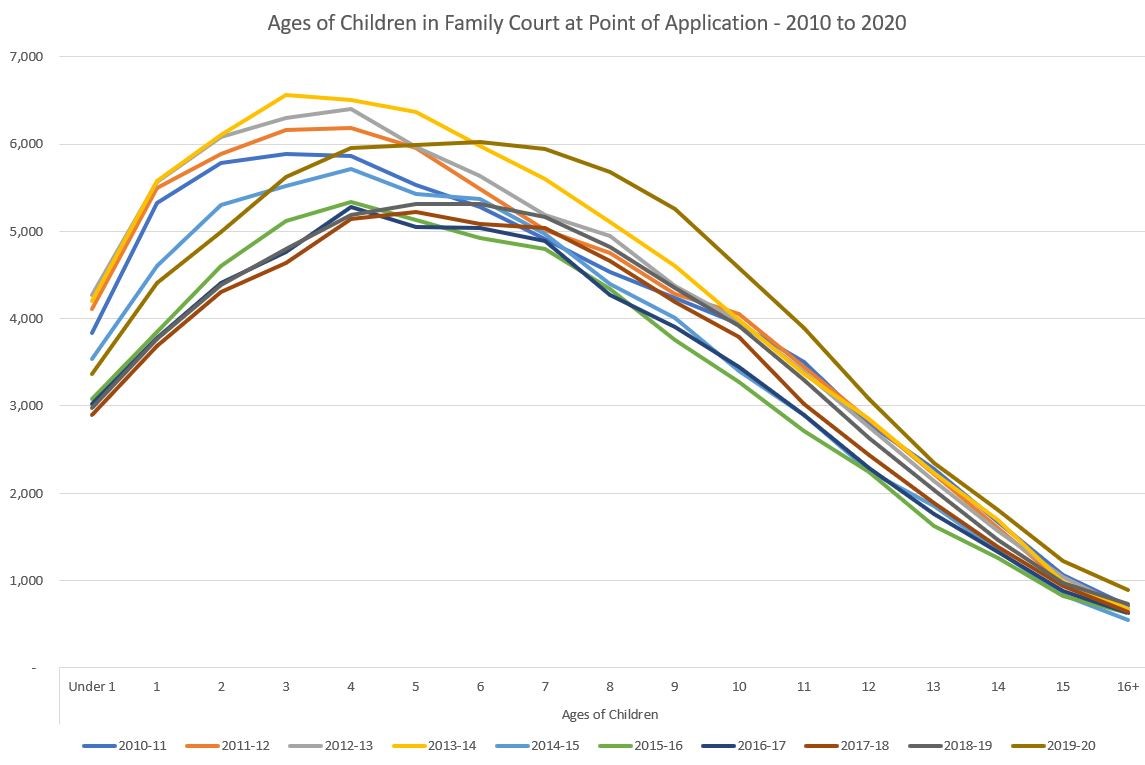
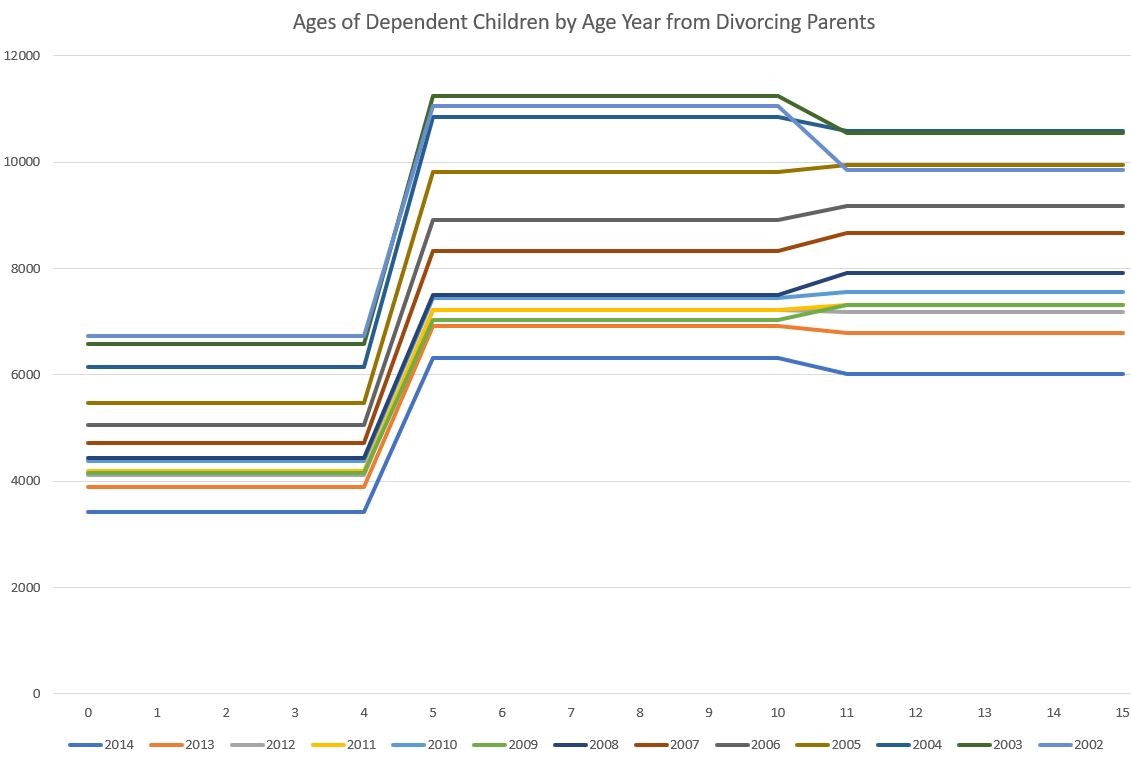
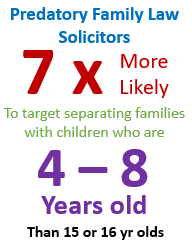
Further useful analysis to consider, is the impact of wasted police time and other wasted resources. If the point raised in 1.2c is anywhere near close, family court processes may be leading to a grossly disproportionate waste of police time & resources when comparing to the relatively low percentage of the population actively engaged in family court cases. This appears to present as approx. 213k DA crime reports which should never have taken place, out of a total number of reports for the whole population of 746,219, that’s 28.54%. If the police have carried out a study to determine the total cost in police resources for domestic abuse crimes, we can predict that as much as 28.54% of that expenditure could be avoided and is being completely wasted. What we do know from publicly available police reporting is that in 2017, 14% of all crimes committed were flagged as domestic abuse crimes[11], we also know that the police budget for that year was £11.783bn, therefore if police spending is directly proportionate, then in excess of £471m in police funding is being wasted by family court related false allegations of domestic abuse. Making assumptions on wasted Cafcass and court time is easy, but we are potentially saying here that, of the 62% of private family law cases which have allegations of abuse, more than 95% are bogus. The remaining 38% of cases very likely take up substantially less court time & judicial resource, which could mean that 80% of the judicial resources, which amount to approx. 1,000 judges costing in excess of £150k annually each in salary alone, could be cut by around 70%, that would save the tax payer in excess of £100m in judges salaries, before we even consider the colossal back office support operation. We are also saying that 95% of Cafcass time assigned to private law cases is completely unnecessary and could be done away with if the presumption of equal care were brought into law, rebuttable of course if there is a genuine safety reason for it to be otherwise or the parents simply agree between themselves to coparent in such a way that suits their lives, minimises conflict and maximises care & stability for the children, but then of course, those type of reasonable, compassionate and child centred parents don’t resort to family court anyway, albeit there seem to be very few of them left once the lawyers get involved. Page 66 of Cafcass 2018/19 Annual report shows total running costs of almost £160m, it seems certain that at least half of this expenditure would be avoided with the introduction of presumed parenting equality.
I've said before that 80% of family court time for private law cases is a complete waste, and these figures back that up. 95% of all social services (external to Cafcass) time spent on private law cases is also completely wasted. In 2019 the Dept for Education reported to have almost 30k social workers employed in Children’s Services[12], with average salary circa £30k + 16% pension, but with 20% of those staff being agency staff at much higher pay rates. Conservatively this is a cost to the tax payer of £1.05bn in salary costs alone, however there are no reports to tell us the proportion of those staff required for private family law purposes. The missing part seems to be, what is the impact of the wasted police time, resource and funding on genuine victims of crime because it’s being wasted by lawyer led, and family court incentivised, manufactured "disputes"? The real cost however, is in the damage being done to more than 15% of our children, and 10’s of thousands of innocent parents every year, as many of 2,000 of whom will take their own lives, a figure that is rising year on year, but is swept quietly under the carpet.
Busting the myth that Domestic Abuse is Gendered
The narrative in relation to domestic abuse is that the majority of victims are female and the majority of perpetrators are male, but on the strength of the calculations in this document, such an assertion is on extremely shaky ground, so let’s look at that in more detail.
We have already identified on page 2 that Police recorded 746,219 domestic abuse crimes, and these are split two thirds female victims (479,479), against one third male victims (248,739). Next, we need to look at whether mothers or fathers are predominantly gaining residency of the children, to serve as our guide to who is likely to be making the lion’s share of false domestic abuse allegations. Our most reliable guide to this (because MoJ refuse to publish these figures despite how very easy it would be to do so) is Child Maintenance Service (CMS) data which has a very large sample size of data to refer to (which is publicly available and updated quarterly on the DWP website), and tells us that children are primarily with mothers in 93% of cases[13], shared equally in just under 5% of cases and primarily with the father in a little over 2% of cases. To pre-empt challenges to that assumption which are likely to come forward, lets back up the CMS data with MoJ data in respect of Non-molestation orders granted in family law cases, which have steadily run at approx. 94% in favour of mothers for at least the last decade[14]. So, to be generous, let’s make the assumption that 93% of the time false allegations are made on the mother’s side, and 7% of the time they are made on the father’s side. Let’s now take 93% of what we believe to be 213k of police crime reports which are false and have been generated for the purposes of family court litigation, and we arrive at a figure of 198,090.
Now we deduct this figure from the male perpetrated domestic abuse crime reports figure of 479,479 and we have a figure of 281,389, but we then add back the 14,910 (7% assumption of false allegations from fathers) to the figure of male perpetrated domestic abuse and we have a final male perpetrated DA crime report figure of 296,299.
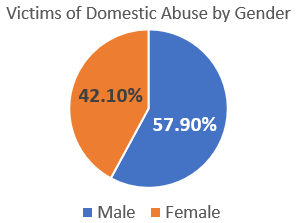
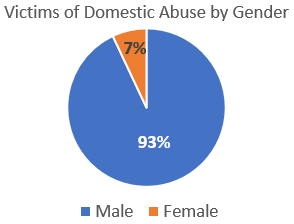
We reach these figures without taking into account three other important factors:
1. That male domestic abuse victims are known to under report, being 3 x less likely to report than females[15].
2. Responses to our Victims of False Allegations in Family Court Survey have highlighted a disturbing level of secondary domestic abuse, perpetrated by relatives, friends and new partners of their accuser, on behalf of their accuser, as a ‘domestic abuse by-proxy’, with over 70% having been subjected to this type of abuse. Such incidents would rarely, if ever, be recorded as domestic abuse, and certainly not attributed to the person inciting the abuse.
3. We could also further dilute the sample if we take into consideration Lesbian and Gay partnerships which represent approx. 2% according to the ONS in 2017. It is noteworthy that according to a study by the University of Bristol in 2006[16] focusing on domestic abuse within same sex couples, of those identifying as Lesbian 40.1% said they had experienced domestic abuse in a same sex relationship, whereas with male respondents identifying as Gay that figure was 35.2%.
If the women’s domestic abuse charities and their advocating MP’s are correct in their thinking, i.e. that government must provide disproportionate protection to the most likely gender to be victims of Domestic Abuse, then the gendered description that they are seeking in the Domestic Abuse Bill must go in favour of men and in particular it must have additional protections for fathers involved in family court proceedings, who are, on the basis of this calculation, our society’s most vulnerable gendered victim group when it comes to domestic abuse - the overwhelming majority of the time! It is also the case, that based on this, the funding given to Women’s Domestic Abuse charities, which is now estimated to be in excess of £500m per year, should have at least half of that funding diverted to male domestic abuse charities, who are estimated to receive less that £2m of funding between them, as a matter of the utmost urgency.
However, there would be few males that would advocate for such an unequitable approach to domestic abuse, I have no doubt about that. It is also the case, based on this analysis that there is a further group of people that would be ignored were we to simply reverse the gendered description of domestic abuse that the women’s groups are campaigning for. These are the thousands of mothers each year who are both alienated and falsely accused in family court, they do not number as highly as men, but so what, they are still victims of abuse who are not being supported, and in many cases they also are being abused by domestic abuse charities and the courts as an abuse by-proxy.
Collectively, alienated parents, of either gender, represent the most vulnerable, and the least supported, group within our population. It is little wonder then, that so many resort to suicide or have a complete mental health breakdown as they try to navigate their way through the abuse. No specific investigations are made by the Coroner’s Office into whether victims of suicide have had recent involvement with family court, there seems to be a compelling argument for this to change. However, estimates for total numbers of male suicide due to family court were at 2,000 each year several years ago, with a spike of 700+ suicides overall in the last year, that is likely to be considerably higher now. The economic cost of each individual suicide is estimated to be £1.7m[17]. Therefore, if the 2,000 figure is accurate the total economic cost of those family court induced suicides is £3.4bn.
It is clear from the content of this analysis, that The Domestic Abuse Bill, now proceeding to the House of Lords for approval, MUST protect ALL VICTIMS as individuals rather than continuing to provide protection through the lens of any form of gendered ideological perspective, founded on the wildly misleading misrepresentation of public data. We have already seen just how damaging that has been for our children and our society generally. For parliament to now go ahead with providing any gendered definition of Domestic Abuse within any changes to the law, against the background of this statistical analysis, would plainly be an act of unjustifiable discrimination at best, and at worst it paves the way for a continuation of the attack against our nation’s children and innocent parents by the family law industry and domestic abuse charities.
Reading this document you might ask yourself the question, “surely there is a regulator overseeing this who would step in?”, and you would be right to ask that question, and the answer is yes, there is a regulator in the form of The Solicitors Regulation Authority (SRA), an arm of The Law Society. In September 2018 I submitted a Freedom of Information Request to the SRA for details on all complaints regarding family law solicitor conduct over the prior 21 months. This revealed that from a total of 1013 complaints over this period, only 8 were upheld, seven of which received only a “Letter of Advice”, i.e. naughty naughty don’t do it again, and the remaining 1 was awarded costs. In practice, this means that there is no regulation in family law, and there is no recourse for malpractice, breaches of conduct or fraud, with the chances of successfully complaining to the regulator and any meaningful action being taken amounting to less than 0.001%. It seems unfeasible that so few complaints out of so many lodged, could legitimately have no merit.
Conclusion
Sir Andrew McFarlane is yet again complaining publicly that Family Court is at breaking point with unprecedented demand [18], and yet it is this very demand that is also leading to other public services being needlessly overstretched. It appears that human behaviour needs to be managed through the setting of clear rules around marriage, separation and divorce, which would limit the incentive for conflict to arise, that incentive largely fuelled by an adversarial system which is very lucrative to the vested interests of family law solicitors, high profile domestic abuse charities, the judiciary and other professionals feeding off this system.
Were there a presumption of equal parenting time from separation (as recommended in the first draft of the Norgrove Report in 2011, but lobbied against by Women’s Aid and Family Law professionals on the thinly veiled basis that it would be devastating to their financial vested interests), which of course is rebuttable on the basis of genuine child safety issues, then we are most of the way there, and there are many examples now around the world that show us how successful a policy this is in reducing court involvement, the associated conflict and harm caused to children.
Sweden, for example, has a rate of just 9% of separating couples turning to the family court[19]. In the UK however, the MoJ have previously estimated that 38% of divorcing couples with children resort to family court, but even that is grossly misleading. In 2018 there were a total of 90,871 divorce petitions filed (ONS[20]), approx. 45% of those had dependent children (circa 40,892). In the same year, there were 53,164 new private law cases lodged with the family court involving 123,334 children[21]. MoJ estimate that 32% of their cases involve unmarried parents, therefore the total number of divorcing couples within family court would amount to approx. 36,152 which tells us that of those divorcing couples with dependent children, a staggering 88.4% are resorting to family court, almost 10 x that of Sweden, but an even higher multiple still when you consider the figure for Sweden is for all divorce matters compared to the figures shown for UK only relating to children matters. Australia also brought in a system of equal parenting successfully in 2006; however, this has been undermined to a large degree (in no small part due to family law solicitors) by a recent spiralling in the volume of false allegations of abuse (e.g. the Pauline Hanson Inquiry to Australian Family Law[22]).
Therefore, to back up the presumption of equal parenting, tough measures around allegations of abuse being made by one parent, subsequently proven false, must be applied - as a disincentive to making them in the first place. Prevention, after all, is always better than cure!
Now that we have reached near saturation of the ‘addressable market’ in divorcing parents with dependant children in family court (88.4%) to continue to grow this business at the pace of recent years, the system will need to turn its attention to unmarried but cohabiting parents for its supply and also to encouraging the failure of a higher proportion of parental relationships (hence the ever increasing funding of Women’s Aid and Refuge charities and the associated inflation of domestic abuse prevalence within their marketing activities). The means to achieve this are already well in train, with the Cohabitation Rights Bill 2019 – 2021[23] which will provide unmarried parents the same financial incentives to alienate children from their other parent as we already have in divorce, as well as giving family law solicitors free reign to plunder the financial estates of unmarried parents to the same level that they have been doing with divorcing parents for several decades. As increasingly fewer couples of child bearing age now marry, not least due to the risks involved and no doubt in no small part to their own experiences growing up with family court involvement, this bill usurps individuals’ decisions to avoid marriage for the sake of their own safety. Once this bill becomes law in 2021, we can safely predict that the percentage of unmarried parents in family court will rise steadily from 32% over the following years.
Perhaps the biggest question is, how many more years will pass, how many more children will be harmed, and how many more innocent parents will take their own lives, before government stops investing tax payers money into the perpetuation and continuing escalation of this abuse?
I invite challenges to the figures in this document by email (see footer), however any challenges that are abusive or disrespectful in their nature will not receive a response. If you wish to challenge, please do so on a mathematical, statistical or logical basis. Likewise, if you wish to discuss the content for media review, publication or interview regarding this analysis or any of my other research please reach out to me by email in the first instance.
For any readers who have been a victim of false allegations in family court, or if you are a loved one of someone who took their own life as a result of false allegations and the family court process, please complete our survey at www.falseallegationssurvey.com, the survey will run until at least September 2020 and may be extended to the end of the year. An interim report of the survey’s findings will be published in August 2020.
Further studies will follow, including a study on the impact of the family law industry on business and the economy. If you are a board member of a large enterprise, and would be interested in playing part in the collection of data from your employees (anonymously of course) please make contact.
If you in a country other than the UK where family law is also operating on a fraudulent level, I urge you to undertake the same statistical analysis with information from your country that will be in the public domain. It is highly likely that the information is available and you’ll be able to reach similar conclusions as I have in this paper as a result. The more we can share this sort of information around the world the better, including any nations that would like to run a tailored version of the false allegations survey mentioned above. I can share the question set as a template to help move you forward more quickly and it would be a useful exercise to publish data from all similar systems around the world. I could even host the survey for you if you are able to meet the cost. Reach out to the email address in the footer. If not us then who, if not now then when?
[4]https://www.ons.gov.uk/peoplepopulationandcommunity/crimeandjustice/articles/domesticabuseandthecriminaljusticesystemenglandandwales/november2019
[8]https://www.ons.gov.uk/peoplepopulationandcommunity/crimeandjustice/articles/domesticabuseprevalenceandtrendsenglandandwales/yearendingmarch2019
[9]https://digital.nhs.uk/news-and-events/latest-news/one-in-eight-of-five-to-19-year-olds-had-a-mental-disorder-in-2017-major-new-survey-finds
[11]https://www.ons.gov.uk/peoplepopulationandcommunity/crimeandjustice/bulletins/crimeinenglandandwales/yearendingmarch2019
[12]https://assets.publishing.service.gov.uk/government/uploads/system/uploads/attachment_data/file/782154/Children_s_social_work_workforce_2018_text.pdf
[13] See Table 3 - https://assets.publishing.service.gov.uk/government/uploads/system/uploads/attachment_data/file/875248/separated-families-population-statistics-april-2014-to-march-2018.ods
[14] These are not published publicly but rather obtained through quarterly Freedom of Information requests to Ministry of Justice, details can be provided on request or by making FoI request to MoJ.
[16]https://www.researchgate.net/profile/Catherine_Donovan/publication/228537060_Comparing_Domestic_Abuse_in_Same_Sex_and_Heterosexual_Relationships/links/09e41511b44a628873000000/Comparing-Domestic-Abuse-in-Same-Sex-and-Heterosexual-Relationships.pdf
[18]https://www.theguardian.com/law/2019/jul/03/family-courts-running-up-a-down-escalator-due-to-increase-in-cases